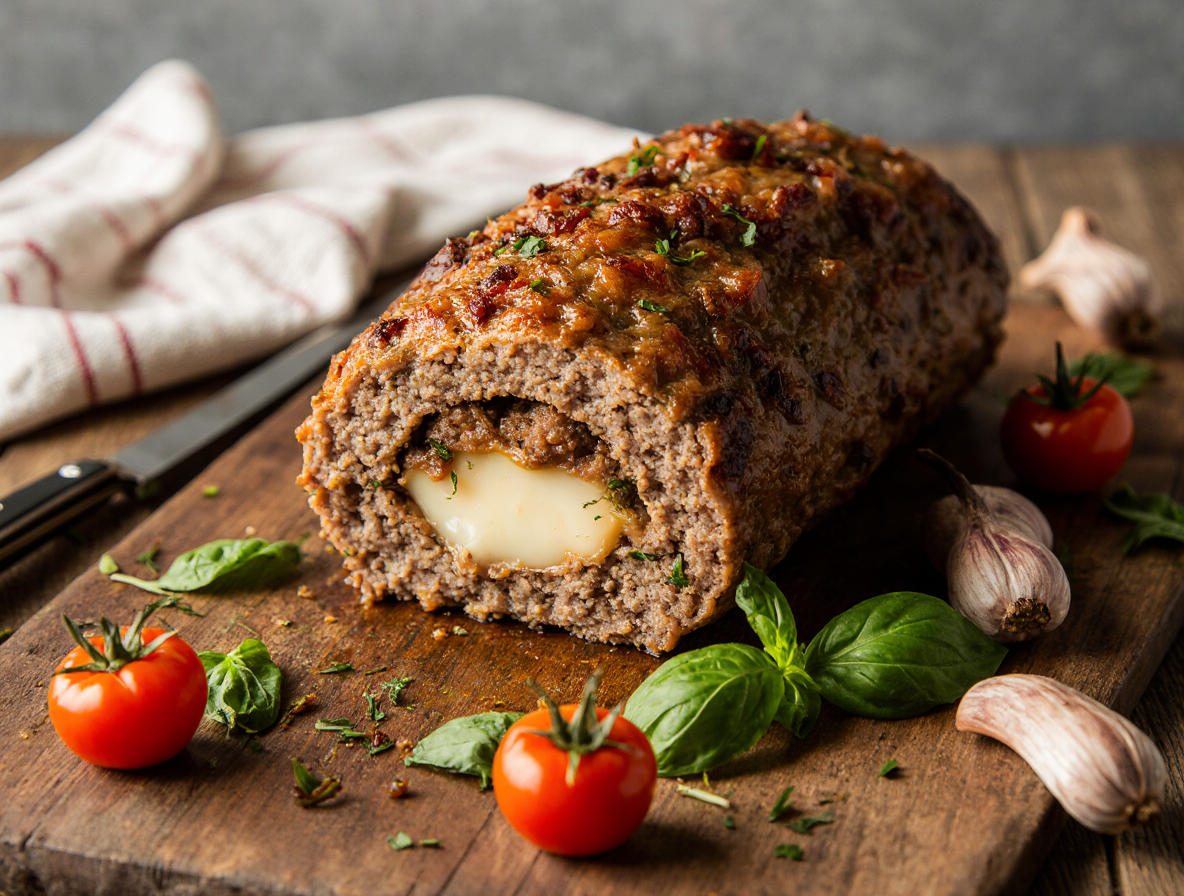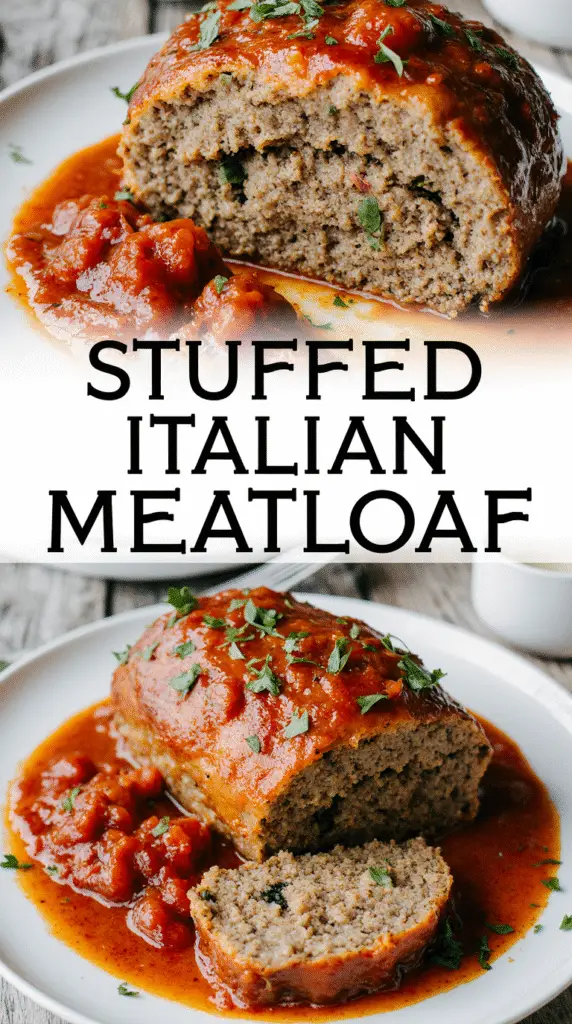How to Make Italian Stuffed Meatloaf: A Foolproof Family Recipe
Looking for an Italian stuffed meatloaf recipe that’s guaranteed to impress? Essentially, what we’re talking about is a polpettone – a large, oblong-shaped meatball baked in a loaf pan without the sauce. This hearty dish packs 277 calories per serving with a satisfying balance of 17g fat, 9g carbs, and 21g protein.
While this cheesy Italian meatloaf isn’t a light meal for sure, comfort food isn’t supposed to be light! Our Italian cheese stuffed meatloaf recipe takes just 1 hour and 5 minutes to prepare, making it perfect for busy weeknight dinners or weekend family gatherings. Additionally, this stuffed Italian meatloaf reheats wonderfully and makes crazy good sandwiches with the leftovers.
Throughout this article, we’ll guide you through creating this fun, delicious, and different dinner option step by step. From selecting the best ground chuck (ideally 80% fat for optimal flavor) to properly inserting a meat thermometer so the bulb reaches the center of your loaf, we’ve got you covered with all the details you need for meatloaf success.
Gathering the Right Ingredients
The success of your Italian stuffed meatloaf recipe begins with selecting quality ingredients. Each component plays a crucial role in creating that perfect balance of flavors and textures that makes this dish truly special.
Choosing the best ground meat blend
For the best Italian stuffed meatloaf, the meat blend deserves careful consideration. Ground chuck with 80% lean meat is ideal because it contains enough fat to keep your meatloaf moist, juicy, and firm enough to hold its shape. Furthermore, a 50/50 combination of ground beef and ground pork creates outstanding flavor and texture. This mixture adds richness and depth that simply cannot be achieved with lean beef alone. If you prefer using just beef, select one with 15-30% fat content rather than extremely lean options that might result in a dry, crumbly texture.
Recommended cheeses for stuffing
Cheese selection dramatically impacts your meatloaf’s character. For authentic results, consider these options:
- Mozzarella – Creates that classic stretchy, melty texture
- Fontina – Offers rich, nutty flavor
- Gruyere – Provides sophisticated depth
- Scamorza – Delivers a slightly smoky note
Importantly, purchase cheese from the deli counter rather than pre-shredded varieties, as bagged cheeses contain anti-clumping agents that affect melting quality. About 1½ cups of shredded cheese or 9 slices will suffice for a standard recipe.
Greens and other filling options
Fresh greens transform an ordinary meatloaf into something extraordinary. Arugula offers a peppery bite, whereas spinach provides milder flavor. Kale or even dandelion greens can substitute beautifully. For baby spinach, no pre-cooking is necessary—the leaves will naturally wilt inside the meatloaf. Nevertheless, when using frozen spinach, first thaw and drain thoroughly to prevent excess moisture from making your meatloaf mushy.
Optional add-ins like ham or roasted peppers
To elevate your Italian stuffed meatloaf recipe, consider incorporating:
Deli ham slices create an extra layer of salty flavor that pairs perfectly with cheese. Prosciutto works particularly well in rolled meatloaf recipes, acting as a protective shield for other ingredients. Roasted red peppers add sweet, smoky notes and vibrant color. Fresh basil leaves alongside the cheese create a classic Italian flavor combination that’s simply irresistible.
Experiment with these options to create your own signature version of this family-pleasing dish.
Preparing the Meatloaf Base
Creating the perfect base for your Italian stuffed meatloaf requires careful attention to both ingredients and technique. Once you’ve selected quality meats, it’s time to transform them into the foundation of your masterpiece.
Mixing meat with breadcrumbs, eggs, and seasoning
The secret to a moist, flavorful Italian stuffed meatloaf lies in the proper ratio of ingredients. First, aim for breadcrumbs or other fillers to make up 15-25% of your mixture. For a 2-pound meatloaf, this means using approximately ¾ to 1 cup of breadcrumbs. Next, add one to two large eggs per pound of meat – they serve as essential binders that keep everything together while adding moisture.
For seasoning, kosher salt is crucial – generally one teaspoon per pound of meat brings out the savory flavors. Italian seasoning, minced onions, garlic powder, and Worcestershire sauce create that authentic Italian flavor profile. Consider adding a tablespoon of ketchup or tomato sauce directly into the mix for extra moisture and richness.
Tips to avoid overmixing
Overmixing is perhaps the most common mistake in meatloaf preparation. When you work the mixture too much, protein fibers cling together, resulting in a tough, dense, and dry final product. To prevent this, combine all non-meat ingredients first before gently folding them into your ground meat.
For those who dislike handling raw meat, a stand mixer with paddle attachment on low speed works well. Simply mix until ingredients are just combined – about 30 seconds or until the mixture begins making a slightly sticky sound.
How to test seasoning before baking
Since tasting raw meat mixture isn’t safe, there’s a simple solution. Form a small patty or meatball from your mixture and quickly cook it in a pan. Alternatively, microwave a small portion for about 30 seconds. After sampling, adjust seasonings as needed before shaping your entire loaf.
This testing step might seem extra work, yet it’s absolutely worth it to ensure your Italian cheese stuffed meatloaf has perfect flavor before committing to the full baking time.
Stuffing and Rolling the Meatloaf
The assembly process transforms your Italian stuffed meatloaf recipe from ordinary to extraordinary. This crucial step determines how impressive your final dish will look when sliced, revealing those beautiful swirls of ingredients.
How to layer cheese, greens, and extras
After preparing your meat mixture, it’s time for the fun part. First, spread the meat evenly onto your surface, creating a rectangular shape approximately 12×8 inches. Next, arrange your fillings in clear layers:
- Bottom layer: Meat mixture (leave 1-inch border all around)
- Middle layers: Cheese slices or shredded cheese (pressed gently into meat)
- Top layers: Spinach, ham slices, roasted red peppers, or fresh basil
For cheese options, fontina, gruyere, firm mozzarella, or scamorza work exceptionally well. Importantly, deli-sliced cheese creates more consistent results than pre-shredded varieties.
Using parchment or wax paper to roll
Parchment paper serves as your secret weapon for perfect rolling. Place your meat mixture on a large sheet of parchment paper, flatten it into your rectangle, then add toppings. Subsequently, lift the short end of the parchment paper to start rolling the meatloaf jellyroll style. The paper guides your rolling action, making this potentially messy step surprisingly manageable.
Sealing edges to prevent leaks
Once rolled, position your meatloaf seam-side down on the parchment paper. Afterward, firmly press the edges and ends together, pinching to create a complete seal. This technique prevents the delicious cheese from escaping during baking. Most importantly, ensure no stuffing ingredients are visible through the meat layer.
Common mistakes to avoid
Overstuffing ranks as the number one error – an overstuffed meatloaf will fall apart during cooking. Another critical mistake involves preparing the meatloaf hours before baking; doing so may cause the meat touching the spinach mixture to remain red with undesirable texture. Additionally, failing to let the meatloaf rest for 10 minutes before slicing results in cheese oozing everywhere instead of staying beautifully contained within each slice.
For best results, handle the meat mixture gently throughout the entire process, as overworking makes the final texture tough and dense.
Baking and Serving Your Italian Stuffed Meatloaf
The final phase of your Italian stuffed meatloaf journey brings everything together as the oven transforms your carefully crafted creation into a mouthwatering masterpiece.
Oven temperature and timing
First, preheat your oven to 350-375°F (175-190°C). Place the meatloaf on the middle rack for even heat distribution. Baking times vary based on size and ingredients – most Italian stuffed meatloaf recipes require 45-70 minutes of total baking time. For optimal results, some recipes recommend initial baking for about 40-45 minutes, followed by a final stage with toppings[191].
How to know when it’s done
Your Italian cheese stuffed meatloaf is fully cooked once the internal temperature reaches 160°F (71°C) on an instant-read thermometer[181]. Insert the thermometer into the thickest part of the loaf for accurate readings. Upon finishing, allowing your stuffed Italian meatloaf to rest for 5-15 minutes proves absolutely essential. This resting period lets juices redistribute throughout the meat, making slicing easier and ensuring each piece holds its shape[193].
Topping with sauce and cheese
Once your Italian meatloaf with cheese has baked for its initial period, remove it to add toppings. Spread tomato or marinara sauce across the top, letting it drip slightly down the sides[201]. Sprinkle with additional cheese – Parmesan or mozzarella work beautifully[201]. Return to the oven for approximately 5-15 minutes more until cheese melts and turns slightly golden[201].
Serving suggestions and side dishes
Cheesy Italian meatloaf pairs magnificently with classic sides. Consider:
- Potato options: Mashed potatoes, roasted potato wedges, or creamy polenta
- Vegetable sides: Sautéed spinach, green beans, roasted peppers, or broccoli[214]
- Italian classics: Pasta with marinara, garlic bread, or a fresh Caprese salad[211][214]
For leftovers, store in an airtight container in the refrigerator for up to one week.
Conclusion
This Italian stuffed meatloaf recipe truly stands as a testament to classic comfort food at its finest. Throughout this guide, we’ve walked through each critical step to create this impressive dish. The right meat blend, quality cheeses, and fresh greens come together to form something far beyond an ordinary meatloaf.
Your patience during preparation will absolutely pay off when you slice into your masterpiece, revealing those beautiful spirals of cheese and fillings. Family members and guests will undoubtedly ask for seconds when presented with this flavorful creation.
Remember, success hinges on several key factors. The 80/20 ground chuck provides ideal fat content for moisture. Gentle handling prevents the dreaded dense texture. Additionally, proper sealing keeps those delicious fillings where they belong – inside your meatloaf!
Best of all, this versatile dish works for both special occasions and weeknight dinners. Leftovers transform into spectacular sandwiches the next day, though you might find yourself with an empty dish sooner than expected.
We hope this foolproof family recipe becomes a staple in your cooking repertoire. The combination of Italian flavors, melty cheese, and hearty meat offers comfort food perfection that will bring everyone rushing to the dinner table time after time.
FAQs
Q1. What makes Italian stuffed meatloaf different from regular meatloaf? Italian stuffed meatloaf features a flavorful blend of ground meats, Italian seasonings, and a delicious filling of cheese, greens, and sometimes cured meats. It’s rolled up jellyroll-style, creating beautiful spirals when sliced.
Q2. How long does it take to cook an Italian stuffed meatloaf? Typically, an Italian stuffed meatloaf takes about 45-70 minutes to bake in a preheated oven at 350-375°F (175-190°C). The exact time may vary based on size and ingredients.
Q3. What’s the best way to prevent the cheese from leaking out during baking? To prevent cheese from leaking, ensure you seal the edges of the meatloaf well after rolling. Place the meatloaf seam-side down and firmly press the edges and ends together, creating a complete seal.
Q4. Can I prepare Italian stuffed meatloaf in advance? While you can mix the meat mixture ahead of time, it’s best to stuff and roll the meatloaf just before baking. Preparing it too far in advance may affect the texture of the meat touching the spinach mixture.
Q5. What are some good side dishes to serve with Italian stuffed meatloaf? Italian stuffed meatloaf pairs well with various sides. Consider serving it with mashed potatoes, roasted vegetables, pasta with marinara sauce, garlic bread, or a fresh Caprese salad for a complete Italian-inspired meal.


